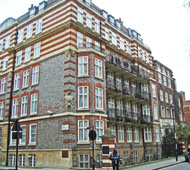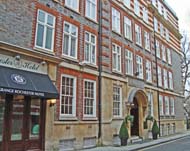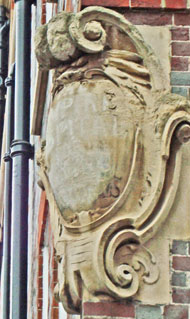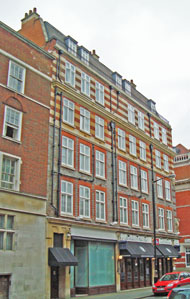Nursing home, then military
The Empire Hospital opened in December 1913, intended to receive paying patients, primarily visitors from overseas. It was not a hospital in the sense of having medical or surgical staff attached, but a nursing home. Patients paid between 3 guineas (£3.15) to 10 gns (£10.50) a week, including board and nursing (nursing homes usually charged 15 gns (£15.75) a week). The majority of rooms in the Hospital cost between 6 to 8 gns (£6.30-£8.40). The resident nurses were under the supervision of a Matron, and patients were attended by their own doctors.
The building had been carefully designed and suitably arranged for the comfort of patients and convenience of the attending clinicians. The 4-storey brick building was built in a mixture of grey and brown brick on three sides of a courtyard. It faced Vincent Square on one side and Rochester Row on the other. The construction was fireproof, with fire escapes for each corridor leading to an external iron staicase.
The top floor was occupied by two up-to-date operating theatres, painted with white gloss paint. The large windows were double, but with hot pipes between to prevent any draughts reaching the patient on the operating tables. The pail for soiled dressings had a lid that was raised by pressing the pedal with a foot. In addition, there was an anaesthetic room, a surgeon's dressing room and an additional room for patients.
The other floors were mainly occupied by the patients' rooms, 40 in all, varying in size and outlook. Each floor had its own bathroom. All the floors were finished in terrazzo laid on concrete, with rounded corners.
Many of the patients' rooms had a French window, which opened onto balconies overlooking Vincent Square. The walls were painted a delicate French grey, with curtains in a matching tone. Colour was provided by pretty rugs, chair coverings and vases of flowers. Each room had an electric fire, even though the building had central heating. Outside each patient's door was a rack for the hospital charts and, below that, a compartment for letters. The corridor floors were covered with thick carpet to deaden the sound of footsteps. A novel arrangement had been installed for turning the lights of the corridors down low at night. The building had a central lift and a staircase. Telephones were fitted throughout.Over the sluice sink, where the bedpans were washed, was a shelf formed of hot pipes, ensuring that the bedpans were always warm.
The Hospital had an X-ray Department and an Electric Treatment Room with various modern appliances.
In the kitchen, which was located in the basement and had special ventilation, the cooking was done by electricity and gas. There was a service lift to all floors. The nurses had a dining room and sitting room of their own.
At the beginning of 1916 the Hospital was taken over by the War Office for the treatment of officers suffering from traumatic paraplegia and brain injuries caused by bullet and shrapnel wounds. It was then known as the Empire Hospital for Officers (for Injuries to the Nervous System).
Patients were first taken to the London Hospital, under the care of the neurologist, Henry Head (1861-1940), who had been appointed as a civilian consultant to the Empire Hospital. Enlisted men were then transferred to the King George Hospital, where a Spinal Unit had been set up by Head, while the officers went to the Empire Hospital. Head, together with his protege Capt. George Riddoch (1888-1947) (the Resident Medical Officer in charge of the Empire Hospital), took advantage of the opportunities provided by the casualties of war to study the phenomena of gross lesions of the spinal cord. Their published research greatly increased medical understanding of the problems of bladder dysfunction and cortical disorders of sensation and vision. Sadly, treatment of spinal injuries by the time of WW2 was no better than it had been in 1918.
The Hospital closed in 1919.
Present status (February 2009)
The building is now the Grange Rochester Hotel.


The Hospital building is on the corner of Vane Street and Vincent Square. Another storey has been added at some time in the past. The Vincent Square frontage is fitted with balconies (left). Although the mailing address is 69 Vincent Square, the main entrance to the building is in Vane Street (right).


The stone carving on the corner of the building is still there (left), but the letters for 'The Empire Hospital' have almost been obscured by time.

The Rochester Row elevation.
(Author unstated) 1913 The Empire Hospital. British Journal of Nursing, 20th December, 524.
(Author unstated) 1914 A hospital for the middle class. British Medical Journal 1 (2766), 43.
Silver JR 2009 The specialty of spinal injuries in the UK. Journal of the Royal College of Physicians of Edinburgh 39, 79-87.
http://newspapers.nla.gov.au
http://rcnarchive.rcn.org
www.aim25.ac.uk
www.london-footprints.co.uk
www3.westminster.gov.uk
Return to home page